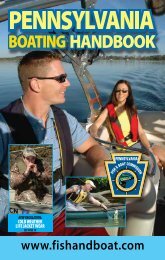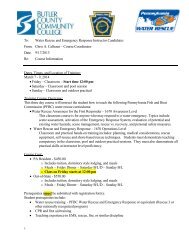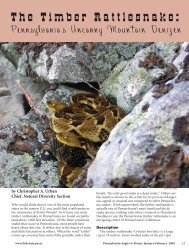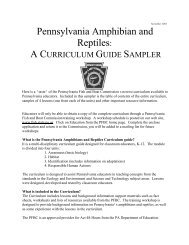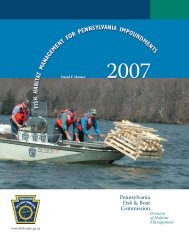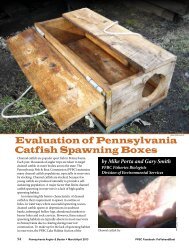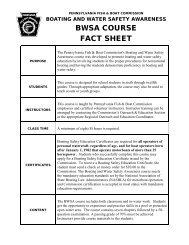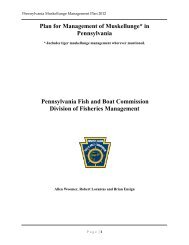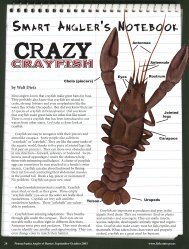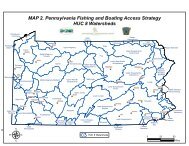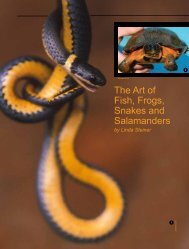pennsylvania angler 1953 - Pennsylvania Fish and Boat Commission
pennsylvania angler 1953 - Pennsylvania Fish and Boat Commission
pennsylvania angler 1953 - Pennsylvania Fish and Boat Commission
You also want an ePaper? Increase the reach of your titles
YUMPU automatically turns print PDFs into web optimized ePapers that Google loves.
The line should be well greased to<br />
float <strong>and</strong> the leader should be as long<br />
<strong>and</strong> as fine as possible to allow the<br />
nymph to tumble freely in the current.<br />
Drag should be avoided in the first<br />
part of the drift but it can be utilized<br />
to advantage when the fly begins to<br />
swing below the <strong>angler</strong>. When the<br />
deeply drifting nymph pulls taut<br />
against the line it swings toward the<br />
surface in an arc that emulates the<br />
ascent of the natural when it emerges<br />
into the dun stage. This is often a<br />
critical point; trout sometimes follow<br />
the nymph as it drifts freely <strong>and</strong> take<br />
it when it makes its upward swing.<br />
Often the take will be delayed until<br />
the nymph reaches the surface—to the<br />
everlasting satisfaction of the <strong>angler</strong><br />
who likes to see the fish strike. One<br />
of the fondest pictures to come to<br />
my mind is of a heavy, brashly colored,<br />
nineteen inch rainbow that rolled to<br />
the surface <strong>and</strong> took my condor quill<br />
nymph as it drifted over a sunken<br />
boulder.<br />
The deep, freely drifting nymph is<br />
very effective when the fish are lying<br />
on the bottom during periods of surface<br />
inactivity. Particular attention<br />
should be paid to underwater ledges,<br />
boulders, undercut banks, <strong>and</strong> other<br />
places of obvious cover for it is here<br />
that the larger trout will be found.<br />
This can be very exciting, albeit subtle<br />
business. The trout take the nymph<br />
confidently as it drifts to them <strong>and</strong><br />
they seldom have to move more than<br />
a few inches to take the lure if it is<br />
travelling at proper depth. This makes<br />
it necessary for the <strong>angler</strong> to rely on<br />
his sense of sight for he will rarely<br />
feel the fish take as in downstream,<br />
taut line fishing. This is where the importance<br />
of the floating line enters in.<br />
If the end of the line stops, twitches,<br />
or moves against the current it should<br />
be treated as a take. There is no need<br />
to strike hard; a smooth tightening of<br />
the line will hook the fish without<br />
danger of leader breakage.<br />
Upstream nymph fishing is not<br />
always feasible in small, shallow<br />
streams <strong>and</strong> the downstream cast often<br />
becomes the better method because the<br />
<strong>angler</strong> has better control over his fly.<br />
This is particularly true on narrow,<br />
brush lined pools where casting space<br />
is limited to the head <strong>and</strong> tail of the<br />
pool. Here the nymph can be cast<br />
downstream on a slack line from the<br />
head of the pool, allowing it to drift<br />
naturally with the current until the<br />
desired drift is completed. Then a<br />
shuttling retrieve will bring the nymph<br />
back—swimming it through whatever<br />
"I know you like your coffee strong so I put<br />
some lye in it."<br />
pockets or cover the <strong>angler</strong> wishes to<br />
guide it.<br />
Pockets in broken water are often<br />
very productive in nymph fishing <strong>and</strong><br />
they should be given special attention.<br />
In pocket fishing a short line is generally<br />
used <strong>and</strong> the nymph should<br />
drift deeply, allowing the current to<br />
eddy it around in the little whirlpools<br />
that are created behind rocks.<br />
In <strong>Pennsylvania</strong> we are blessed with<br />
some exceptional limestone streams—<br />
streams which in physical make-up are<br />
counterparts of the celebrated chalk<br />
streams of the British Isles. These<br />
streams are almost unbelievably rich<br />
in insect life <strong>and</strong> the trout that they<br />
harbor certainly bespeak high living.<br />
These fish are epicures, carefully<br />
choosing their fare <strong>and</strong> growing fat<br />
from the vast cuisine the limestone<br />
streams offer. Slower, more placid sections<br />
of these streams are almost invariably<br />
bordered by lush beds of<br />
watercress or other aquatic vegetation,<br />
<strong>and</strong> in this vegetation live the scuds—<br />
known locally as "cress bugs." These<br />
are little crustaceans—almost nymphlike<br />
in appearance—that abound by the<br />
thous<strong>and</strong>s in the water weeds <strong>and</strong> they<br />
furnish a choice <strong>and</strong> ever-abundant<br />
food for the trout.<br />
These limestone waters are fruitful<br />
hunting grounds for the nymph fisherman<br />
<strong>and</strong> many beautiful trout have<br />
been taken by fishing the condor quill<br />
nymph very slowly along the edges<br />
of the weed beds. We use twelve to<br />
fourteen foot leaders for this fishing<br />
because the water is deep <strong>and</strong> the<br />
nymph must literally "crawl" through<br />
the outer fringes of weeds.<br />
As is inevitable in such rich waters,<br />
the limestone streams occasionally produce<br />
trout that far exced the average<br />
trout in length <strong>and</strong> weight. These<br />
legendary giants are seldom seen; even<br />
more rarely are they hooked <strong>and</strong><br />
l<strong>and</strong>ed. But they are there, <strong>and</strong> once in<br />
a while a luckly <strong>angler</strong> turns up with<br />
one.<br />
No discussion of nymph fishing<br />
should overlook midge nymphs for,<br />
much as midges are cursed, the little<br />
beasts are here to stay. The occurrence<br />
of midges seems to be sporadic over the<br />
summer but it is usually late in the<br />
season when the trout really take a<br />
fancy to them. Many an otherwise rational<br />
fisherman has torn his hair out<br />
watching trout dine on these "unseeables,"<br />
yet midge nymphs are often<br />
great medicine for these difficult trout,<br />
providing the artificial is small enough<br />
IF YOU WOULD<br />
CATCH MORE<br />
TROUT —<br />
KILL LESS!<br />
MAY—<strong>1953</strong> 87



